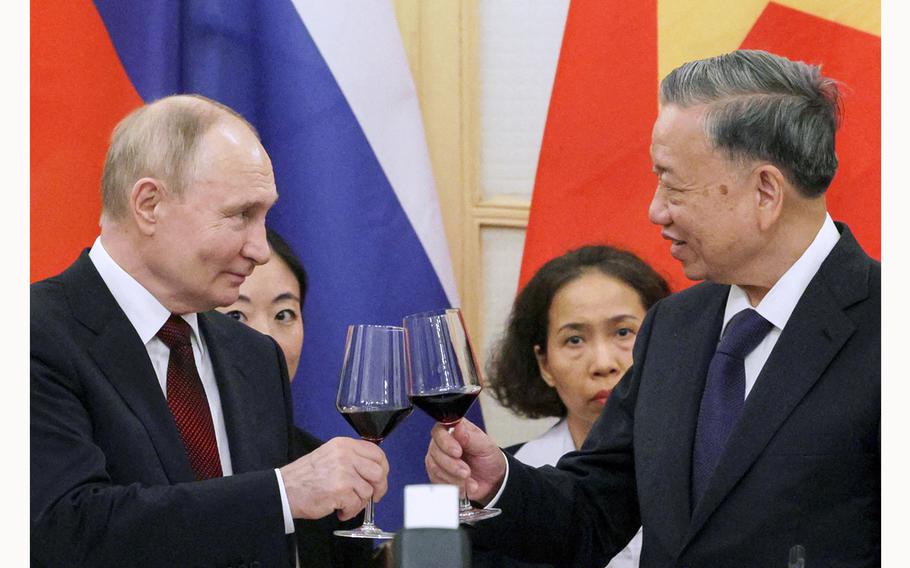
Russia’s President Vladimir Putin and Vietnam’s President To Lam toast during a reception at the Hanoi Opera House in Hanoi on June 20, 2024. (Gavriil Grigorov/Sputnik/Pool/AFP via Getty Images/TNS)
(Tribune News Service) — Russian President Vladimir Putin’s trip to Asia won him support to maintain his grinding war on Ukraine while alarming U.S. allies such as South Korea, which is now considering supplying Kyiv with weapons that could change the battlefield.
Putin returned to Russia after visits to North Korea and Vietnam that resulted in a military pact with Pyongyang that bound the two U.S. adversaries even closer and raised the risks of military action on the Korean Peninsula.
Putin and North Korean leader Kim Jong Un agreed Wednesday to come to each other’s defense if one is attacked. While it remains to be seen what the lasting impact of the visit will be, in the short term it will likely push Japan and South Korea to bolster their relationship and their bonds with the U.S., which have already become stronger over the past year. It also left China on the sidelines, an unusual position for North Korea’s biggest benefactor.
President Joe Biden, Japanese Prime Minister Fumio Kishida and South Korean President Yoon Suk Yeol are likely to meet next month for a summit where the U.S. is likely to reaffirm its commitment to extended deterrence, or the “nuclear umbrella” it provides for its Asian allies. Yet the message that Kim’s rule over North Korea would end if he tried to use nuclear weapons may be met with a new element of doubt.
“If there is a contingency, the U.S. president will have to think not only about North Korea’s nuclear weapons, but about Russia’s nuclear weapons, so we can foresee a situation where U.S. extended deterrence is weakened,” said Tetsuo Kotani, professor of global studies at Meikai University. “We can’t assume everything is absolutely fine.”
The U.S. and its allies have accused Kim of sending millions of rounds of artillery and scores of ballistic missiles to Putin for his war on Ukraine. The weapons gained in prominence as Kyiv’s supplies dwindled due to the U.S. Congress holding up new military aid. But with President Volodymyr Zelenskiy’s government now taking delivery of billions of dollars in fresh arms from its U.S. and European allies, the window for a Russian breakthrough is narrowing.
Kim hailed the deal as “the most powerful treaty” signed between the two countries, but Putin was more cautious in his wording. “I would like to underline that this agreement is not something new,” Putin said in Vietnam, adding the deal had the same wording as an agreement from the early 1960s.
Putin also downplayed any speculation North Korea could send troops to join the fight in Ukraine, saying no one asked about it and no one offered it.
Seoul responded to the deal by saying it’s considering whether to end its ban on sending lethal weapons to Ukraine. Japan is unlikely to follow suit, Kotani of Meikai University said, but the pact sparked a flurry of diplomatic activity.
Both countries and the U.S. denounced the deal as well as the arms transfers, which they say violate United Nations Security Council resolutions. Japanese and South Korean foreign ministers held a call to share their concerns over the pact, and both countries announced more Russia-related sanctions. The South Korean government summoned Russia’s ambassador to make a formal protest, while Japan’s Defense Minister reiterated that U.S. nuclear deterrence is indispensable.
Artillery Supplies
The Koreas have two of the world’s largest artillery forces, with thousands of large caliber guns pointed at each other. Their stockpiles of shells include North Korean ones that are inter-operable with Soviet-era artillery that Russia has deployed to the front-lines in its war. South Korean 155 millimeter caliber shells meanwhile are the standard used by the NATO countries supplying Ukraine.
South Korea has completed a review of the steps that would be taken for sending weapons to Ukraine with its 155 mm artillery shells likely at the top of the list, South Korea’s Yonhap News reported, adding the stock is estimated at over 3 million shells. Seoul may be less worried about depleting its inventory after seeing North Korea drawing down theirs by sending to Russia what Seoul believes to be more than 4 million shells.
While South Korea’s current policy prohibits sending lethal aid to nations at war, that hasn’t stopped its arms makers from selling weapons to Ukraine’s European neighbors. Exports have surged since Russia’s full scale invasion of Ukraine, mostly to buyers seeking to replace Soviet-era weaponry with higher tech arms from the Asian country.
Despite the increased unease, the trip may not have changed the balance of power in the region, said Rachel Minyoung Lee, a senior fellow with the 38 North Program at the Stimson Center.
“What we just saw are two internationally isolated countries formalizing cooperation across various areas, much of which has the potential to violate sanctions, for example North Korea-Russia cooperation on space and peaceful nuclear energy,” Lee said.
“China still looms large, and the U.S. alliances with South Korea and Japan and U.S.-South Korea-Japan security cooperation remain intact,” said Lee who worked as an analyst for the CIA’s Open Source Enterprise for almost two decades. “North Korea has won itself an extra protection cover against its external threats, namely the U.S., South Korea, and perhaps even China,” she added.
With assistance from Isabel Reynolds, Yoshiaki Nohara and Youkyung Lee.
©2024 Bloomberg L.P.
Visit bloomberg.com
Distributed by Tribune Content Agency, LLC.